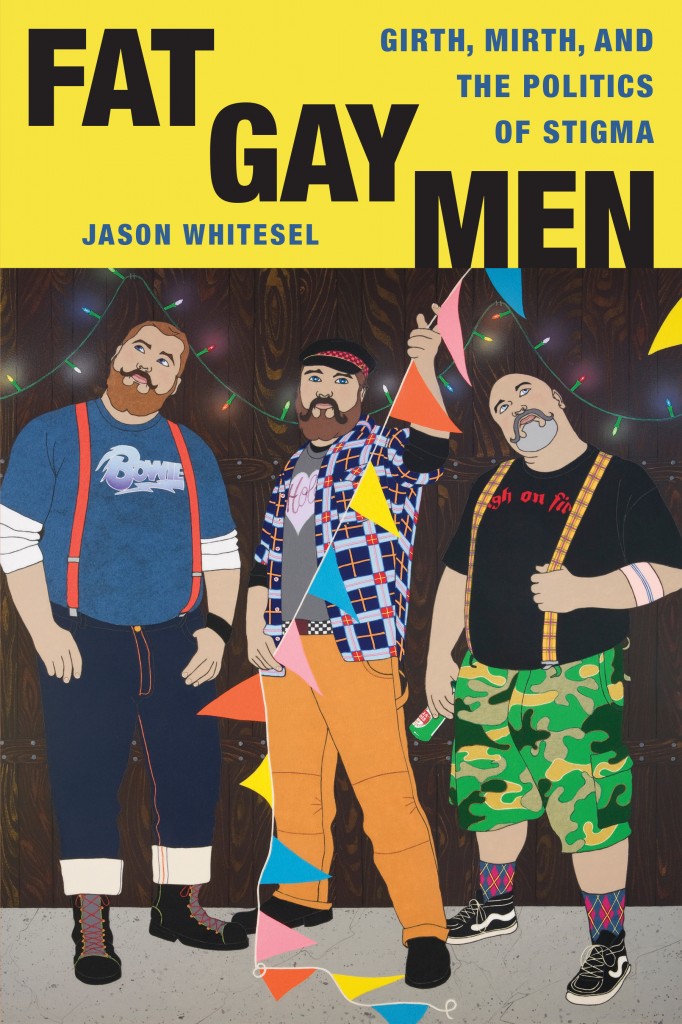—Jason Whitesel
I recently finished my first book, Fat Gay Men: Girth, Mirth, and the Politics of Stigma, which offers an inside look at “Girth & Mirth,” a gay social club where members nurture each other’s joy in being fat and happy. As a gay man who participated in Girth & Mirth—therefore as a partial insider, yet admittedly with thin privilege, white privilege, and a professor’s privilege, among others—I want to share my critique of the wider gay community’s sizism.
As Marcia Millman observed almost 35 years ago, in Such a Pretty Face: Being Fat in America, “when a homosexual man is fat, he is often viewed in the gay community as not having sufficient ‘self-pride.’” Indeed, fat gay pride is a difficult subject position to sell; and when the Girth & Mirthers I studied invited other big gay men to join their cause, they opened themselves up to public rejection, as if it weren’t already difficult to be personally rejected because of their size and sexual orientation. I have witnessed these men being chastised for wanting to participate in annual Pride parades and being told they are embarrassments to the gay community.
Girth & Mirthers are often left out of Gay Pride media coverage; yet they persist despite their invisibility, seeking group recognition. As Lory Britt and David Heise put it so aptly, while “shame may lead to hiding, . . . pride may lead to expansive behaviors in public space.” The growing sense of pride Girth & Mirthers feel parallels their ample body size, which is even reflected in our language when we say: “He swelled with pride.” Indeed, pride makes one feel bigger and stronger and stand taller.
With the protection and backing of their fellow sufferers in Girth & Mirth, members move toward reconfiguring their shame. For some, being in the Pride parade means they come out twice: for being gay and for being fat. In a 2006 San Francisco Bay Times article, Sister Dana Van Iquity quips tongue-in-cheek on the homogenization of Pride: “The Girth & Mirth club will be asked to either not be fat or at least not show a sense of humor about their stout state. After all, we would not want the public to think that a bunch of happy, chubby gays represented our community, now would we?!” Thus, this author affectionately acknowledges the existence of big men in the gay community. Sister Dana’s remarks point out the contradiction that if gays are open to making fun of themselves in campy-queer drag, they need not be so threatened by Girth & Mirthers’ presence in the gay community.
When Girth & Mirthers participate in Pride celebrations, they not only gain visibility, but also communicate an alternate message: not all gay men are pretty-perfect and chiseled. As queer theorist J. Jack Halberstam puts it, taking pride in one’s shame is like going to “a place where shame can be transformed into something that is not pride, but not simply damage, either.” Girth & Mirthers take pride in their shame, sometimes going to the extreme to present a fun, larger-than-life persona. Despite acutely feeling the sting of rejection from those who are sizist, big gay men march in Pride parades and put themselves out there something fierce.
Therefore, with Pride Month upon us, it’s my belief that the road to accepting those groups that continue to be marginalized within the gay community—people of size as well as transgender folks, people with disabilities, and/or racial-ethnic minorities—must involve more than simply tolerating these groups. It requires all of us to embrace a wider range of diversity unremarkably, and without fuss. Fat activists put it best when they say, “We’re here, we’re sphere, get used to it!”
Jason Whitesel is Assistant Professor of Women’s and Gender Studies at Pace University in New York. He is the author of Fat Gay Men: Girth, Mirth, and the Politics of Stigma (forthcoming in July from NYU Press).

